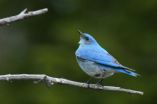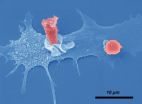(Press-News.org) Berkeley — Two new studies by scientists at the University of California, Berkeley, provide a clearer picture of why some species move in response to climate change, and where they go.
One study, published online Monday, Aug. 6, in the journal Global Change Biology, finds that changes in precipitation have been underappreciated as a factor in driving bird species out of their normal range. In the other study, published today (Wednesday, Aug. 15) in the journal Proceedings of the Royal Society B, researchers found a sharp decrease in range for the Belding's ground squirrel, but noted some surprising areas where the species found refuge.
The two studies exemplify the type of research being explored through the Berkeley Initiative in Global Change Biology, or BiGCB, an ambitious effort to better understand and predict how plants and animals will respond to changing environmental conditions by studying how they have responded to earlier periods of climate change.
The first study's findings challenge the conventional reliance on temperature as the only climate-related force impacting where species live. The authors noted that as many as 25 percent of species have shifted in directions that were not predicted in response to temperature changes, yet few attempts have been made to investigate this.
"Our results redefine the fundamental model of how species should respond to future climate change," said study lead author Morgan Tingley, who began the research as a graduate student in UC Berkeley's Department of Environmental Science, Policy and Management. "We find that precipitation changes can have a major, opposing influence to temperature in a species' range shift. Climate change may actually be tearing communities of organisms apart."
The findings are based upon data gathered from the Grinnell Resurvey Project, which retraces the steps of Joseph Grinnell, founder of the UC Berkeley Museum of Vertebrate Zoology, in his surveys of Sierra Nevada wildlife from the early 1900s. The resurvey project, which began in 2003, was led by Craig Moritz, former UC Berkeley professor of integrative biology, and his colleagues at the Museum of Vertebrate Zoology.
For the bird study, the researchers included 99 species in 77 historic survey sites in Lassen Volcanic, Yosemite and Sequoia national parks, as well as in several national forests. In the century that has passed since the original Grinnell survey, summer and winter temperatures have increased an average of 1-2 degrees Celsius in the Sierra Nevada. Yosemite experienced the most warming — with average temperatures increasing by 3 degrees Celsius — while parts of Lassen actually got cooler and much wetter.
Among the bird species that moved upslope are the Savannah Sparrow, which shifted upward by 2,503 meters, and other meadow species such as the Red-winged Blackbird and Western Meadowlark. The ones that shifted their range downslope include both low-elevation species like the Ash-throated Flycatcher and Western Scrub-Jay, and high-elevation species like the Cassin's Finch and Red-breasted Nuthatch.
"Temperature did not explain the majority of these shifts," said Tingley, who is now a postdoctoral researcher at Princeton University's Program in Science, Technology and Environmental Policy. ''Only when we included precipitation as an explanatory variable did our models adequately explain the movement patterns we observed."
The researchers found that while rising temperatures tended to push birds to cooler regions upslope, increased precipitation, which is more common at higher elevations, pulled them downslope.
"We believe many species may feel this divergent pressure from temperature and precipitation, and in the end, only one wins," said Tingley.
Notably, more than half of the bird species in each of the three study regions did not shift their range despite pressures from climate change. "Moving is a sign of adaptation, which is good from a conservation standpoint," said Tingley. "More worrisome are the species that have not shifted. How are they adapting? Are they moving, but we just can't detect it? Or are they slowly declining as environmental conditions gradually become less ideal where they live?"
The answers are complex, as illustrated by the second UC Berkeley paper about range changes for a species of squirrel found in the mountains of the western United States.
In that paper, researchers again used information obtained from the Grinnell Resurvey Project. Through visual observations and trapping surveys conducted throughout the mountains of California, they discovered that the Belding's ground squirrel had disappeared from 42 percent of the sites where they were recorded in the early 1900s. Extinctions were particularly common at sites with high average winter temperatures and large increases in precipitation over the last century.
"We were surprised to see such a dramatic decline in this species, which is well-known to Sierran hikers and was thought to be fairly common," said study lead author Toni Lyn Morelli, a former National Science Foundation postdoctoral researcher who was based at UC Berkeley. "In fact, the rate of decline is much greater than that seen in the same region for the pika, a small mountain-dwelling cousin of the rabbit that has become the poster child for the effects of climate warming in the contiguous United States."
Morelli added that the squirrels are thriving in areas that have been modified by humans. For example, irrigated Mono Lake County Park serves as an artificial oasis that sustains squirrel populations despite otherwise hot and dry conditions in eastern California.
"As predictions indicate that the range of the Belding's ground squirrel could disappear out of California by the end of the century, these areas might be particularly important for this and other climate-impacted species," said Morelli, who is now a technical advisor for the U.S. Forest Service's International Programs in the Democratic Republic of Congo.
Although the Belding's ground squirrel is widespread, the rapid decline in its distribution is of concern because it is an important source of food for raptors and carnivores. However, the paper suggests that even when climate change causes large range declines, some species can persist in human-modified areas.
"Taken together, these two studies indicate that many species have been responding to recent climate change, yet the complexities of a species' ecological needs and their responses to habitat modification by humans can result in unanticipated responses," said Steven Beissinger, professor at UC Berkeley's Department of Environmental Science, Policy and Management and the senior author on both studies. "This makes it very challenging for scientists to project how species will respond to future climate change."
INFORMATION:
Funding from the National Science Foundation, National Park Service, and California Landscape Conservation Cooperative helped support this research.
Studies shed light on why species stay or go in response to climate change
2012-08-17
ELSE PRESS RELEASES FROM THIS DATE:
Less commonly prescribed antibiotic may be better
2012-08-17
Highlights
Vancomycin was the most commonly prescribed antibiotic in dialysis patients for treating certain bloodstream infections, but cefazolin was 38% better than vancomycin at preventing hospitalizations and deaths from these infections.
Cefazolin was also 48% better at preventing sepsis.
Hundreds of thousands of Americans develop bloodstream infections every year.
Washington, DC (August 16, 2012) — The antibiotic most commonly prescribed to treat bloodstream infections in dialysis patients may not always be the best choice, according to a study appearing ...
Blood markers reveal severity of common kidney disease
2012-08-17
Highlights
The blood levels of certain abnormal proteins and the antibodies that attack them rise according to the severity of one of the most common diseases of the kidney.
The findings may help in the diagnosis and management of the disease, called IgA nephropathy.
IgA nephropathy can lead to high blood pressure, swelling and, in some cases, kidney failure.
Washington, DC (August 16, 2012) — Increasing blood levels of particular proteins may act as warning signs for patients with one of the most common diseases of the kidney, according to a study appearing ...
What's your lifetime risk of developing kidney failure?
2012-08-17
Highlights
Approximately 1 in 40 men and 1 in 60 women of middle age will develop kidney failure if they live into their 90s.
People with reduced kidney function face an even higher risk.
Kidney failure is on the rise and currently afflicts 2 million people worldwide.
Washington, DC (August 16, 2012) — How likely are middle-aged adults to develop kidney failure during their lifetime? A study appearing in an upcoming issue of the Journal of the American Society of Nephrology (JASN) provides some insights, which may be used to help set priorities related to kidney ...
Psychopaths get a break from biology
2012-08-17
SALT LAKE CITY, Aug. 16, 2012 – A University of Utah survey of judges in 19 states found that if a convicted criminal is a psychopath, judges consider it an aggravating factor in sentencing, but if judges also hear biological explanations for the disorder, they reduce the sentence by about a year on average.
The new study, published in the Aug. 17, 2012, issue of the journal Science, illustrates the "double-edged sword" faced by judges when they are given a "biomechanical" explanation for a criminal's mental disorder:
If a criminal's behavior has a biological basis, ...
Mouse study finds clear linkages between inflammation, bacterial communities and cancer
2012-08-17
What if a key factor ultimately behind a cancer was not a genetic defect but ecological?
Ecologists have long known that when some major change disturbs an environment in some way, ecosystem structure is likely to change dramatically. Further, this shift in interconnected species' diversity, abundances, and relationships can in turn have a transforming effect on health of the whole landscape – causing a rich woodland or grassland to become permanently degraded, for example – as the ecosystem becomes unstable and then breaks down the environment.
For this reason, it ...
Is too much brain activity connected to Alzheimer's disease?
2012-08-17
High baseline levels of neuronal activity in the best connected parts of the brain may play an important role in the development of Alzheimer's disease. This is the main conclusion of a new study appearing in PLoS Computational Biology from a group at VU University Medical Center in Amsterdam, the Netherlands.
In recent times, it has become clear that brain activity patterns change at an early stage in Alzheimer's disease. Moreover, there is reason to believe that, instead of being the consequence of structural damage, they might be the cause: recently, a direct influence ...
Organisms cope with environmental uncertainty by guessing the future
2012-08-17
In uncertain environments, organisms not only react to signals, but also use molecular processes to make guesses about the future, according to a study by Markus Arnoldini et al. from ETH Zurich and Eawag, the Swiss Federal Institute of Aquatic Science and Technology. The authors report in PLoS Computational Biology that if environmental signals are unreliable, organisms are expected to evolve the ability to take random decisions about adapting to cope with adverse situations.
Most organisms live in ever-changing environments, and are at times exposed to adverse conditions ...
Virus throws a wrench in the immune system
2012-08-17
The cytomegalovirus (CMV) is a member of the herpesvirus family. Although most people carry CMV for life, it hardly ever makes them sick. Researchers from the Helmholtz Centre for Infection Research and from the USA have now unveiled long term consequences of the on-going presence of CMV: Later in life, more and more cells of the immune system concentrate on CMV, and as a result, the response against other viruses is weakened. These research results help to explain why the elderly are often more prone to infectious diseases than young people.
The viral immunologist Professor ...
New form of carbon observed
2012-08-17
Washington, D.C. — A team of scientists led by Carnegie's Lin Wang has observed a new form of very hard carbon clusters, which are unusual in their mix of crystalline and disordered structure. The material is capable of indenting diamond. This finding has potential applications for a range of mechanical, electronic, and electrochemical uses. The work is published in Science on Aug. 17.
Carbon is the fourth-most-abundant element in the universe and takes on a wide variety of forms—the honeycomb-like graphene, the pencil "lead" graphite, diamond, cylindrically structured ...
Black stroke survivors face greater risk from high blood pressure
2012-08-17
Black people who survived strokes caused by bleeding in the brain were more likely than whites to have high blood pressure a year later – increasing their risk of another stroke, according to a study in the American Heart Association journal Stroke.
The study examined racial and ethnic differences in these strokes, called intracranial hemorrhage or ICH. They account for only 10 percent of all strokes but have a death rate of about 40 percent in the first month, much higher than other types of stroke. High blood pressure is the most important modifiable risk factor associated ...


